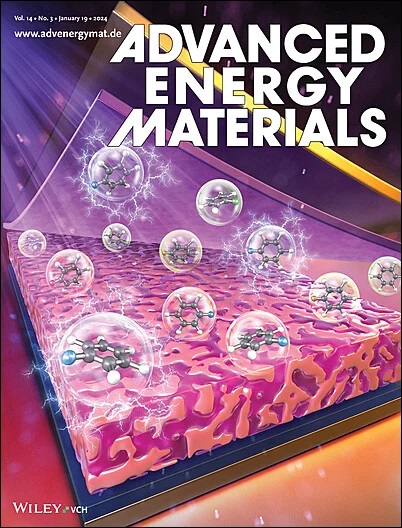Improving Crystallization of Wide-Bandgap Lead Halide Perovskite for All-perovskite Tandems
IF 24.4
1区 材料科学
Q1 CHEMISTRY, PHYSICAL
引用次数: 0
Abstract
Wide-bandgap (WBG) perovskite solar cells (PSCs) are crucial component of tandem solar cells (TSCs). However, the main obstacles currently faced by WBG PSCs are their imperfect crystal quality, leading to large open circuit voltage (VOC) losses and poor stability. The use of 2,5-dibromothieno[3,2-B] thiophene (DBrT) as an additive in WBG PSCs enhances crystal quality, mitigates defects, and improves stability by promoting crystal growth and passivating bulk and interface defects. The interaction between Pb─S bonds, π–π stacking, and hydrogen bonding facilitates an ordered molecular arrangement, leading to better crystallization and reduced non-radiative recombination. Meanwhile, DBrT can also spontaneously diffuse to the grain boundary, thus permeate to top and buried surfaces of perovskite, further passivating defects at the interfaces and reducing non-radiative recombination. This strategy not only improves energy level alignment and carrier transport but also achieves a champion power conversion efficiency (PCE) of 22.40% for the inverted WBG PSC with a high VOC of 1.27 V. a PCE of 20.39% for semi-transparent devices, and a high 28.31% PCE for 4-terminal all-perovskite tandem solar cells, thereby offering a comprehensive approach to enhancing the performance of WBG and tandem perovskites.

求助全文
约1分钟内获得全文
求助全文
来源期刊

Advanced Energy Materials
CHEMISTRY, PHYSICAL-ENERGY & FUELS
CiteScore
41.90
自引率
4.00%
发文量
889
审稿时长
1.4 months
期刊介绍:
Established in 2011, Advanced Energy Materials is an international, interdisciplinary, English-language journal that focuses on materials used in energy harvesting, conversion, and storage. It is regarded as a top-quality journal alongside Advanced Materials, Advanced Functional Materials, and Small.
With a 2022 Impact Factor of 27.8, Advanced Energy Materials is considered a prime source for the best energy-related research. The journal covers a wide range of topics in energy-related research, including organic and inorganic photovoltaics, batteries and supercapacitors, fuel cells, hydrogen generation and storage, thermoelectrics, water splitting and photocatalysis, solar fuels and thermosolar power, magnetocalorics, and piezoelectronics.
The readership of Advanced Energy Materials includes materials scientists, chemists, physicists, and engineers in both academia and industry. The journal is indexed in various databases and collections, such as Advanced Technologies & Aerospace Database, FIZ Karlsruhe, INSPEC (IET), Science Citation Index Expanded, Technology Collection, and Web of Science, among others.
 求助内容:
求助内容: 应助结果提醒方式:
应助结果提醒方式:


